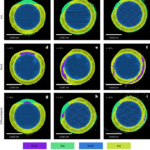2024-04-23 オークリッジ国立研究所(ORNL)
<関連情報>
- https://www.ornl.gov/news/unconventional-technology-enhances-composites-important-automotive-aerospace-and-renewable
- https://onlinelibrary.wiley.com/doi/full/10.1002/advs.202305642
階層的な界面形成による複合材料の靭性向上 Enhancing Composite Toughness Through Hierarchical Interphase Formation
Sumit Gupta, Tanvir Sohail, Marti Checa, Sargun S. Rohewal, Michael D. Toomey, Nihal Kanbargi, Joshua T. Damron, Liam Collins, Logan T. Kearney, Amit K. Naskar, Christopher C. Bowland
Advanced Science Published: 25 December 2023
DOI:https://doi.org/10.1002/advs.202305642

Abstract
High strength and ductility are highly desired in fiber-reinforced composites, yet achieving both simultaneously remains elusive. A hierarchical architecture is developed utilizing high aspect ratio chemically transformable thermoplastic nanofibers that form covalent bonding with the matrix to toughen the fiber-matrix interphase. The nanoscale fibers are electrospun on the micrometer-scale reinforcing carbon fiber, creating a physically intertwined, randomly oriented scaffold. Unlike conventional covalent bonding of matrix molecules with reinforcing fibers, here, the nanofiber scaffold is utilized ‒ interacting non-covalently with core fiber but bridging covalently with polymer matrix ‒ to create a high volume fraction of immobilized matrix or interphase around core reinforcing elements. This mechanism enables efficient fiber-matrix stress transfer and enhances composite toughness. Molecular dynamics simulation reveals enhancement of the fiber-matrix adhesion facilitated by nanofiber-aided hierarchical bonding with the matrix. The elastic modulus contours of interphase regions obtained from atomic force microscopy clearly indicate the formation of stiffer interphase. These nanoengineered composites exhibit a ≈60% and ≈100% improved in-plane shear strength and toughness, respectively. This approach opens a new avenue for manufacturing toughened high-performance composites.



